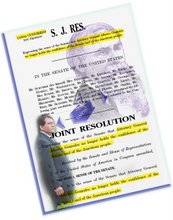LIVE VIDEO -- testimony, at SJC, on the applicability of habeas corpus to gitmo detainees -- december 11, 2007
MEDIA STREAM CONCLUDED]
this is pretty compelling
stuff -- from the prepared
testimony at today's hearing:
Statement of Sen. Patrick Leahy,
Chairman, Senate Judiciary Committee
On “The Legal Rights Of Guantanamo Detainees”
December 11, 2007
Today we consider our treatment of detainees at Guantanamo Bay and how best to secure our nation while holding on to those rights and values that make us American. I thank Senator Feinstein for holding this important hearing.
As today’s testimony potently reminds us, the attack on America on September 11, 2001 was a devastating and tragic blow, and we must take all possible steps to prevent such a tragedy from happening again. But as so much of our history has shown, and as the events of the last six years have again made clear, disregarding the rule of law does not make us safer; it undermines our safety and our place in the world.
Over the last few years, Guantanamo has become for much of the world a symbol of injustice and boundless exercise of power. As General Colin Powell said, “Essentially, we have shaken the belief that the world had in America's justice system by keeping a place like Guantanamo open.”
The Washington Post detailed last week the story of a man whom United States and European intelligence services concluded was innocent, but who isnonetheless still languishing years later in a cell at Guantanamo. The flawed review process there found him to be dangerous, contrary to the clear findings of the intelligence community. These stories are too common. The administration likes to call the detainees at Guantanamo the worst of the worst, but military and government officials have told The New York Times and others that many of the detainees appear to be people who were in the wrong place at the wrong time, and do not pose a threat.
Senator Specter and I have fought hard, and will continue fighting, to restore the great writ of habeas corpus, the legal doctrine that allows someone detained by the government to at least go to a court to say he or she is being held in error. The last Republican Congress and this administration took away that right for any non-citizen held under mere suspicion of being an enemy combatant, or merely “awaiting determination” as to whether that status applied. This is a change in the law that puts every one of the millions of legal, permanent residents in this country at risk, and Guantanamo is the ultimate illustration of the fate they risk sharing. How many more people could end up sitting in cells, unable even to challenge the basis for their detention, forever?
This government has stumbled forward in its handling of the Guantanamo detainees, apparently without rhyme or reason. Some detainees may have been released without a sufficient assurance that they are not dangerous. Others repeatedly found not to be dangerous remain at Guantanamo with no end in sight. The cursory process meant to review whether the detainees are being held properly has been revealed again and again to be hopelessly flawed. We must start over with a fair system based in our law –- the kind of system I proposed setting up soon after September 11 and the kind that Senators Specter and Durbin likewise proposed.
Nothing has done more, though, to damage America’s image and our place in the world as a beacon of human rights than the revelations that we have used cruel interrogation techniques and perhaps even torture. We have just learned that the Central Intelligence Agency destroyed videotapes of harsh interrogations, including the use of waterboarding. One of the CIA employees who participated in interrogating one of the detainees apparently appeared in the videotapes, said that waterboarding was used, that it is torture, and that “Americans are better than that.” I agree.
Senator Specter and I sent a letter yesterday to Attorney General Mukasey asking a series of questions about the Justice Department’s knowledge of and involvement in the CIA’s possession and subsequent destruction of these videotapes. We requested a complete account of the Justice Department’s own knowledge of and involvement with these matters.
America has always been a country that does not torture and one that stands against torture. This administration has abandoned our historic commitment to human rights by repeatedly stretching the law and the bounds of executive power to authorize torture and cruel treatment. All the while, it has tried to keep its policies and actions secret, knowing that they could not withstand scrutiny in the light of day. That is the real message coming out of the recent revelation of the CIA tapes being destroyed, that their practices could not stand up to scrutiny. That matter is not one in which to scapegoat lower level officers but one that raised fundamental questions about what this administration has allowed despite our laws and treaties against torture and cruel and degrading treatment. Until this administration finally comes clean with Congress and the American people about its policy on torture and cruel interrogation techniques, we cannot restore America’s standing as the world leader in protecting and preserving human rights, and only by doing so can we truly safeguard our national security.
Closing the facility at Guantanamo Bay and restoring justice to the way we treat detainees and the legal process we give them would be a good start toward reaffirming the values for which America has always stood.~~~~~~~~~~~~~~~~~~~~~~~
December 11, 2007
Senate Judiciary Subcommittee on Terrorism,
Technology and Homeland Security Hearing
“The Legal Rights of Guantanamo
Detainees: What Are They, Should
They Be Changed, and Is an End in Sight?"
The Statement of Professor
Mark P. Denbeaux, Seton Hall
Law School, Director of the
Seton Hall Law School Center
for Policy and Law
“WHO TO RELEASE AND WHO TO DETAIN IS
THE ONLY QUESTION. HABEAS CORPUS IS
THE ONLY ANSWER”
INTRODUCTION
I appear today to present data demonstrating the failures of the “Guantanamo” process for the detainees and for our Country1. But at the outset I must stress that process failures have morphed into policy debacles. If there is one thing that stands out clearly from the Report I will discuss today and the prior Seton Hall reports, it is that the misinformation that has infected the entire debate about Guantánamo, including in formal hearings before Congress, has been the direct result of failures of our Government to accord the detainees basic legal rights. Had the detainees had such protections of process, the misinformation provided by the highest levels of our Government to the Congress and the American people would have been prevented or, at worst, corrected. Instead, the cloud of secrecy that enfolds the truncated CRST processes (themselves accorded only as the result of Supreme Court intervention), continues to distort policy debates across America and in the halls of Congress.
There are those who still believe that the average Guantanamo detainee was the “worst of the worst”; there are those who still believe that these individuals were captured “on the battlefield” in Afghanistan by American troops. And there are those who still believe that released detainees are still flocking back to the war to resume shooting at American or coalition soldiers.
It is possible, of course, that the individuals who first made these statements believed them to be true. I take no position on that. But the Department of Defense has provided us with the data necessary to show that each and every one of these statements is categorically false. And perhaps most significant, the Department of Defense data belying the statements of our highest level officials occurred only because of the intervention of the United States Supreme Court. There is a message here for the American people and for Congress: if we really want to know how the War on Terror is being waged, much less whether it is succeeding, according basic rights to detainees is an important step. Justice Brandeis’s statement that “sunshine is the best disinfectant” could not be more apt.
Our research reveals that no one should trust the substantive findings of the Government’s process. The core purpose of any procedure – of any legal process – is to accurately determine the rights and duties of those involved. The Department of Defense’s substitute for judicial process fails this test.
The data presented and relied upon by me during my testimony and in the Seton Hall Center for Policy and Research published reports assumes that Department of Defense data is complete and accurate and that the statements made by senior public officials are also true and accurate, except when contradicted by their own data.
The most relevant reports are the report profiling the basis upon which detaineesare being detained,
2 the report reviewing the procedures of the Combat Status Review Tribunal as defined and applied,3 and the latest report, published today, addressing presence on the battlefield before detention and following release. 4 This latest report makes clear that statements that detainees were captured on the battlefield shooting at Americans and the statements that released detainees returned to be killed and captured on the battlefield are not accurate. They are, in fact, highly exaggerated.
There have been 759 people detained in Guantanamo. According to Department of Defense data, despite public assertions to the contrary by senior Department of Defense officials, only one of the 759 detainees was alleged to have been initially captured on a battlefield by United States forces.
Four hundred fifty detainees have been released. According to Department of Defense data, and again contrary to public statements by senior Department of Defense officials, no more than three detainees have been killed or captured after their release. An additional two may be fighting against coalition forces.
This new data refutes all claims by all senior Department of Defense officials about detainee presence on battlefields, both before and after detention.
This finding has important implications for the detainees still held in Guantanamo. The Department of Defense argues that the Combat Status Review Tribunals are fair and free of improper influence, but the continuing pattern of public misstatements about the dangerous of the detainees by the senior Department of Defense officials sent an undeniable signal to the fact finders in the CSRT process. These fact finders are not independent of such influences. They were not Judges in a Court of Military Justice; they were instead the subordinates of the senior officials publicly mischaracterizing the detainees, the reason for their detention, and their post-release conduct.
Basic Elements of Valid Adjudicative Process
There are several basic elements of valid legal process:A. An independent tribunal; and
B. Basic minimum process requires weighing the private interests against the government’s asserted interest by a process sufficient to accomplish the substantive goal.
Civilian courts and military courts meet both requirements for fairly resolving the rights of the litigants and the interests of the State. The CSRT process fails to protect either party.
The most important, among a number of defects, is the lack of independent tribunals. The CSRT tribunals were entirely dependent, and therefore likely to be influenced by the repeated public misstatements of fact made about the detainees by senior Department of Defense and even higher officials. These fall into two main categories:
First, that the detainees were “the worst of the worst” and had been caught fighting American forces on the battlefield, and
Second, that dozens of the released detainees had been recaptured or killed on the battlefield, fighting Americans, after they were released from their detention at Guantanamo.
Few of the Detainees Can Be Classified as the “Worst of the Worst”
The first Seton Hall report compared the public statements made by the senior Department of Defense officials about the detainees as against the Department of Defense data.
Senior officials, including then Secretary of Defense Donald Rumsfeld, described the detainees as “the worst of the worst” even though the Department of Defense data concluded that fully 55% of detainees were not even accused of committing a hostile act against the United States or coalition forces.
The first report also demonstrated that the public statements by senior Department of Defense officials that the detainees were captured on the battlefield shooting at American and coalition forces were inaccurate. In fact, the Department of Defense data showed that only 21 detainees were captured on the battlefield.
Only 24 detainees were captured by United States forces (the majority of the remainder was turned over to the United States in exchange for cash bounties). Of all the detainees, only one (1) could have been captured on the battlefield shooting at Americans, because only one was both captured by the United States forces and captured on a battlefield.
Very Few Released Detainees Engage in Hostilities Thereafter
Department of Defense senior officials have publicly claimed that dozens of former Guantanamo detainees were captured or killed during battles with American forces following their release. This public representation was entirely inaccurate every time it was uttered.
First, implicit in the claim that detainees have “returned to the battlefield” is the notion that such a detainee was on a battlefield prior to his detention in Guantanamo. As the Seton Hall reports demonstrate, and as previously mentioned, only (21) were accused of having been on a battlefield.
As recently as April of 2007 the public assertions were that “approximately 30” released detainees had been killed or captured on the battlefield. That public statement was never true. It was false every time it was uttered.
Just as the Government’s claims that the Guantánamo detainees “were picked up on the battlefield, fighting American forces, trying to kill American forces,” do not comport with the Department of Defense’s own data, neither do its claims that former detainees have “returned to the fight.” The Department of Defense has publicly insisted that at least thirty (30) former Guantánamo detainees have “returned” to the battlefield, where they have been re-captured or killed. To date, however, the Department has described at most fifteen (15) possible recidivists, and has identified only seven (7) of these individuals by name. More strikingly, data provided by the Department of Defense reveals that:at least eight (8) of the fifteen (15) individuals identified alleged by the Government to have “returned to the fight” are accused of nothing more than speaking critically of the Government’s detention policies; ten (10) of the individuals have neither been re-captured nor killed by anyone; and of the five (5) individuals who are alleged to have been re-captured or
killed, two (2) of the individuals’ names do not appear on the list of individuals who have at any time been detained at Guantánamo, and the remaining three (3) include one (1) individual who was killed in an apartment complex in Russia by local authorities and one (1) who is not listed among former Guantánamo detainees but who, after his death, has been alleged to have been detained under a different name.
I must interject a personal note.
If the Department of Defense really considers that criticism of the United States is engaging in militant activities and if the Department of Defense truly believes that the whole world is a battlefield, then my testimony before this committee is also militant anti-American activity. I reject, as abhorrent, such a charge and I am confident that my fellow citizens reject such a policy as a violation of all that America stands for.
In sum, at that time, the Department of Defense report could only confirm two (2) detainees as having been killed or captured on a battlefield after being released from Guantanamo. Another detainee was reportedly killed in a Russian apartment in June 2007. Thus, of the approximately four hundred forty-five (445) detainees that have been released from Guantanamo, no more than three (3) detainees, or less than one percent (1%), have subsequently returned to the battlefield to be captured or killed.
The Misstatements of Fact Affected the CSRT Decision-makers
The statements by senior Department of Defense officials that asserted detainees were captured on the battlefield shooting at American soldiers was prejudicial because it was a false characterization of the very data the Tribunals were to evaluate.
The statements by Senior Department of Defense officials that asserted detainees were being captured and killed on battlefields following their release from detention was even more pernicious because it was not true and because it would clearly have a chilling effect on a decision-maker charged with determining whether to release a detainee.

In any event, this kind of data is not necessary to determine whether tribunals were independent. The record is clear that when the tribunals found certain detainees were not Enemy Combatants, the tribunal’s decisions were basically treated as a “mulligan.” That is, the tribunals were told to redo the process –- secretly, without notifying the detainee –- until the detainee was eventually found to be an Enemy Combatant. (See “No Hearing, Hearings."5 No tribunal finding a detainee to be an “enemy combatant” was ever mulliganed.
The message – we know the result we want, and it’s your job to get it – was clear to everyone.
Our conclusions, drawn from the results of the process, were confirmed by an actual participant in the process. Lieutenant Colonel Abraham, a member of a CSRT Panel, who has stated that senior officials interfered with the CSRT process and compelled findings that detainees were Enemy Combatants when tribunals found to the contrary.
THE CSRT PROCEDURES ARE DEFECTIVE ON THEIR FACE AND IN THEIR IMPLEMENTATION
Before the tribunals, all tribunal members were told that the Government had already found the detainee to be an enemy combatant at multiple levels of review.
The Government’s finding rested upon classified evidence that the detainee could never see, and that the Tribunal must presume that was reliable and valid.
Given these rules, the Government sustained its burden necessary to conclude that each detainee was an Enemy Combatant without calling a single witness. It produced documentary evidence in only 4% of the cases.
The Government also prevented the detainees from producing any evidence by leaving to the Tribunals the right to decide that facts sought by a detainee were not “reasonably available.”
All requests for witnesses not already detained in Guantánamo were denied. Even when a detainee requested that witnesses then detained in Guantánamo be produced for testimony, in 74% of the cases those witnesses were denied as well.
Requests by detainees to produce documentary evidence were denied in 60% of the cases. The only documentary evidence that the detainees were allowed to produce was from family and friends.
The detainees were denied lawyers. Instead of a lawyer, the detainee was assigned a “personal representative,” whose role, both in theory and practice, was minimal. With respect to preparation for the hearing, in most cases, the personal representative met with the detainee only once (82%) for no more than 90 minutes (88%) only a week before the hearing (90%). At the end of the hearing, the personal representative failed to exercise his right to comment on the decision in 98% of the cases. During the hearing; the personal representative said nothing 12% of the time. During the hearing; the personal representative did not make any substantive statements in 48% of the cases and in the 52% of the cases where the personal representative did make substantive comments, those comments sometimes advocated for the Government.
CONCLUSION
The resolution of the Guantanamo problem is clear and simple. The United States and the detainees both need a legitimate judicial process to determine the facts. All difficulties arising from and because of Guantanamo can be solved by fair adjudications. The Article III Courts and the Military Courts have served this country well for hundreds of years. They are fully capable of adjudicating all the matters arising from Guantanamo.
There is no cure possible for the pernicious tainting. The internal administrative procedures of the Department of Defense can not be corrected: The taint is too great, the time spent has been too long and the time left is too short for short cuts.
There is one remedy.
The remedy for Guantanamo is habeas corpus.
~~~~~~~~~~~~~~~~~~~~~~~~~~~
Footnotes:
1. None of this work would have been possible without the work of my co-authors, and the student and Senior Fellows of the Seton Hall Law School Center for policy and research. One of these Fellows deserves recognition for his service to his country. Before entering law school he served tours of duty in Afghanistan and Iraq.
2. Feb. 8, 2006 report
3. No hearings report
4. The most recent report.
5. Same as note 3



































































No comments:
Post a Comment